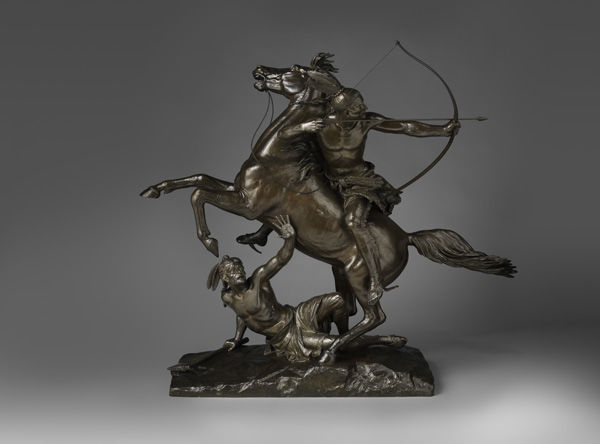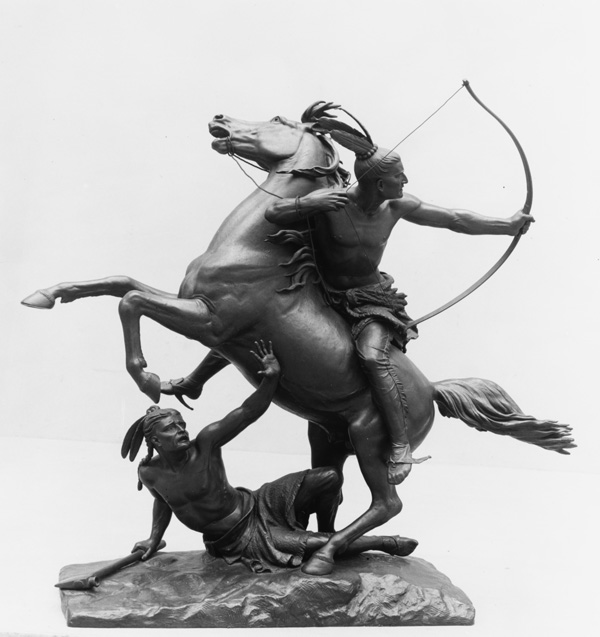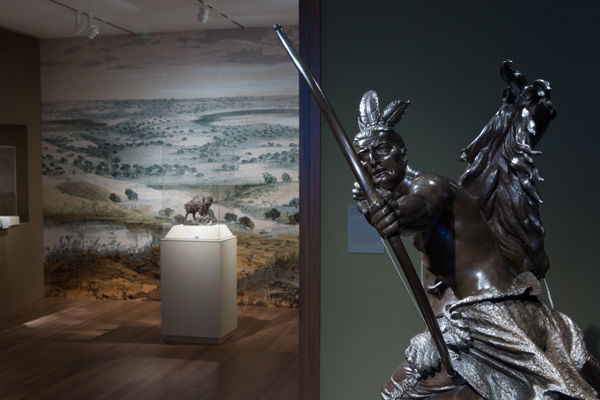
Randolph Rogers (American, 1825–1892). The Last Arrow, 1879–80 (cast 1880). Bronze, 44 x 34 1/2 x 16 in. (111.8 x 87.6 x 40.6 cm). The Metropolitan Museum of Art, Bequest of Henry H. Cook, 1905 (05.13.1)
Born in Waterloo, New York, in 1825, Randolph Rogers studied in Florence before establishing a studio in Rome in 1851, as many American sculptors did in the mid-nineteenth century. Although Rogers specialized in literary and ideal subjects most often carved in Italian marble, he completed at least four compositions featuring American Indians, including The Last Arrow. Cast in Rome in 1880, this dramatic equestrian group depicts two American Indians: a wounded figure, tomahawk in hand, has fallen beneath the rearing horse of his fellow warrior, who precariously turns to aim his drawn bow and arrow at an unseen enemy. The gash on the chest of the fallen man suggests that his wound is from an arrow, and, thus, the result of intertribal combat.
The Last Arrow demonstrates Rogers's mastery of the bronze medium and embodies the drama of the West, and so was at the top of the list of works to be included in the exhibition. However, curator Thayer Tolles and conservator Linda Borsch had to resolve the fact that the figure on horseback had his bow but not his last arrow, an element essential to the sculpture's narrative. After conducting archival research and locating two additional casts of the sculpture—one at the Cincinnati Art Museum, the other in a private collection—it was clear that the artist had conceived of the work with an arrow and that the Met's cast was missing this integral component, as the original threading and pinning holes on its surface also attested.

Randolph Rogers (American, 1825–1892). The Last Arrow, 1879–80 (cast 1880). Photograph, 1913
Although it is not known precisely when or how the "last arrow" was lost, a photograph taken in 1913 at the Met (above) confirms that it has been missing for at least one hundred years, most likely before the sculpture was bequeathed to the Museum in 1905. Upon further inspection, conservator Linda Borsch determined that the existing bow string was not original, and a decision was then made to replicate both the string and the missing arrow.
To execute this treatment, Linda collaborated closely with a conservator at the Cincinnati Art Museum, who provided detailed measurements and photographs of The Last Arrow in Cincinnati's collection. The conservator also took silicone impressions from the original arrow's arrowhead and feathers. Linda used these impressions to create wax models that were then cast in brass. She soldered the reproduction tips to a brass rod of the same dimensions as the original arrow shaft. For the bow string, a piece of copper wire was twisted by hand to replicate the original string. Next, the arrow and string were patinated using chemicals and paint to match the dark brown patina of the sculpture. Finally, the reproduction elements were mechanically attached to the work using the original threading and pinning holes, which Linda described as the most challenging stage in the process.
Although reproductions are somewhat unusual in sculpture conservation, they are, as Linda put it, "a fun part of the job." In Rogers's The Last Arrow, both the arrow and bow string are essential parts of the work, and the reproduction pieces maintain the integrity of the artist's original vision. "Before the intervention, the sculpture looked visually incomplete without the arrow, and given the title of the work, Thayer and I agreed that it was important to replace it," Linda explained.

Visitors to The American West in Bronze, 1850–1925 will encounter this work just prior to entering the introductory gallery, and may find themselves caught in the path of the last arrow!